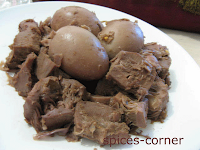The most popular town-associated dishes are:
Pecel MadiunA salad of boiled vegetables, dressed in a peanut-based spicy sauce. It is usually served as an accompaniment to rice. A peanut or dried fish/shrimp cracker (rempeyek) is served on the side.
Soto LamonganChicken soto (an Indonesian cuisine
mainly comprised of broth and vegetables) originated from the town of Lamongan. The soup is usually accompanied by rice or compressed rice
Soto MaduraA turmeric-based beef and offal soup, served with boiled egg, and sambal. It is usually accompanied by rice or compressed rice
Sate MaduraOriginating on the island of Madura, near Java, is certainly the most famous variant among Indonesians. Most often made from mutton or chicken, the distinctive characteristic of the recipe is the black sauce made from soy sauce mixed with palm sugar (called gula jawa or "javanese sugar" in Indonesia), garlic, shallots, peanut paste, fermented "terasi" (a kind of shrimp paste), pecans, and salt. Sate Madura uses thinner chunks of meat than other varians of Satay. It is mainly eaten with rice and venison curry.
Sate PonorogoA variant of satay originating in Ponorogo, a town in East Java. It is made from whole sliced marinated chicken meat, and served with a sauce made of peanuts and chilli sauce. Garnished with shredded shallots, sambal (chili paste) and lime juice. The uniqueness of this varient is each skewer contains a whole chicken meat, not several slices. The meat also previously being marinated in spices and sweet soy sauce for quite some times (process called "bacem") to allow spice to soak into the meat. The grill is made from terracotta earthenware that have hole in one side to allow blowing the wind onto the burning coal. After use around 3 months, the earthenware grill would break apart, thus must be replaced to ensure the hygiene of the grill. The dish served with rice or lontong (glutinous rice cake).
RawonA dark beef soup, served with mung bean sprouts and the ubiquitous sambal. The dark (almost black) color comes from the kluwak (Pangium edule) nuts.
Rujak CingurA mixture of boiled and raw vegetable salad, with a special twist that is the boiled beef snout (cingur) mixed in. It is then dressed in a sauce made of caramelized fermented shrimp paste (petis), peanuts, chili, and spices. It is usually served with lontong, a boiled rice cake.
SemanggiA salad made of boiled semanggi (M. crenata) leaves that grow in paddy fields. It is dressed in a spicy peanut sauce.
Lontong balapLiterally means "racing rice cake", which is a dish of rice cakes, fried tofu, and beansprouts, doused in kecap manis and sambal sauce. In the past, lontong balap hawkers carried their wares in a large, heavy metal urn. The heaviness caused them to have to walk really quickly while carrying it, so they looked like they were "racing".
Tahu campurA beef meat and offal soup, mixed with fresh vegetables, potatoes, rice cake, and tofu. The secret ingredient is the caramelized fermented shrimp pasted (petis) which is mixed in just before serving.
Tahu tekA dish containing cut-up fried tofu, boiled vegetables (mostly beansprouts), potatoes, drenched in a peanut-based sauce. The sauce has caramelized fermented shrimp pasted (petis), chili, and garlic.
Gado-gadoSimilar to pecel, but includes different vegetables as well as boiled egg slices and a garnish of fish/shrimp crackers and emping (Gnetum gnemon L. nut, flattened, dried, and fried into small thin crackers).



















